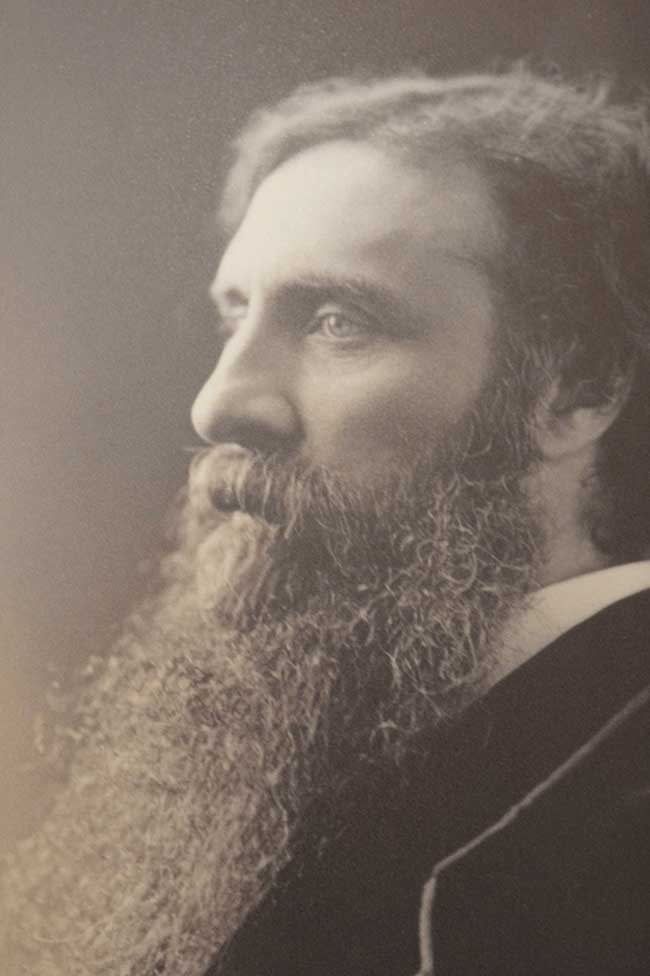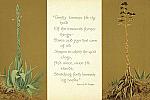“The heart of every flower”

[George MacDonald, c.1865—Provost Skene’s House Museum / [CC BY-SA 4.0] Wikimedia]
In the final months of her life, coworkers gathered in Lilias Trotter’s bedroom for Sunday Bible readings. On one occasion, a younger missionary remembered,
There was in the room one of those pure trumpet flowers of the cactus, and Miss Trotter passed it round and asked if, when we looked deep into its lily-like centre, we didn’t almost see His face! and how He is manifest in the different face of every flower, and quoted George MacDonald “Thy Face the heart of every flower. . . .”
Think of the bright merriment of the buttercup, she told them, the innocent happiness of the primrose, the triumphant shout of the daffodil—each displays a different facet of God’s joy. As the flowers open their petals, “they unveil their mystery, and show their heart; and, looking deep down into them, we can read God in them.”
The phrase “Thy Face the heart of every flower”—from one of MacDonald’s poems—naturally resonated with the flower-loving Trotter. She had spent a lifetime painting, in both pigments and words, their intricate contours and hidden parables. But it also encapsulated a profoundly sacramental way of looking at the natural world that she and MacDonald shared: God is continually speaking to us, showing us his character and his love for us, even communing with us, through creation. And what we see there if we look with eyes of faith, both would have said, is a Father’s heart overflowing with gladness.
Call to joy
It’s unclear whether Trotter ever met MacDonald, though their social circles overlapped—most prominently through their mutual friend, John Ruskin. But she was indebted to his writings, especially Unspoken Sermons (published in three volumes in 1867, 1885, and 1889) and The Diary of an Old Soul (1880), and she embodied in her own life MacDonald’s ideal artist: one whose imagination has been so purified by love for the truth that she could look at anything—a mountain range, a cloudy sky, a human face—and see the glory of God shining through.
Like MacDonald, Trotter saw symbols and metaphors everywhere. She unfolded them, petal by petal, in illustrated devotional books such as Parables of the Cross, which culminates in a call to joy:
Yes, life is the uppermost, resurrection life, radiant and joyful and strong, for we represent down here Him who liveth and was dead and is alive for evermore . . . oh let us not dim it by a shadow of morbidness or of gloom: He is not a God of the dead, but a God of the living, and He would have us let the glory of His gladness shine out.
It’s hard not to hear in this echoes of MacDonald’s novel The Seaboard Parish (1868) that Lilias had read when she was young—a story brimming with joyful resurrections, nature-loving artists, and the shining vision that to give oneself to Christ is to be “a living glory of gladness.”
No wonder, then, that at the end of her life, Trotter drew upon a favorite phrase of MacDonald’s to exhort her friends to let their own joy shine as brightly as that of the lily she held in her hands. The notes for her talk, penciled in a frail woman’s shaky script, were some of the last words she wrote in her journal before she died: “We speak of the God of Love and the God of Peace, so seldom of the God of Joy”—and yet it is the God of Joy whose heart ever beckons to us through the faces of the flowers.
By Jennifer Trafton
[Christian History originally published this article in Christian History Issue #148 in 2023]
Jennifer Trafton is the author of a forthcoming book on Lilias Trotter with B & H Publishing, slated for fall 2024.Next articles
Minds occupied with heaven
Organizing laypeople for piety and service in the Nineteenth Century
Kevin BelmonteChristian History Timeline: Lilias Trotter
A life of art and service. Trotter’s experiences amid the cultural and missional currents of the nineteenth and early twentieth centuries
the editorsCooperation for the gospel
Trotter’s mission was part of the exploding nineteenth-century evangelization of North Africa
Rebecca C. PateSupport us
Christian History Institute (CHI) is a non-profit Pennsylvania corporation founded in 1982. Your donations support the continuation of this ministry
Donate







